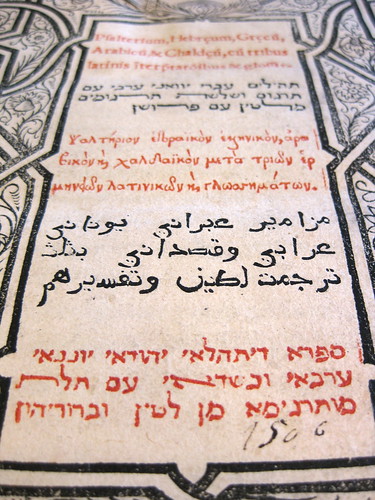
Thursday, August 7, 2014
 PHOTO OF THE WEEK: Polyglot Bible
PHOTO OF THE WEEK: Polyglot Bible
Bible polyglot, each double-page spread having eight columns containing the text of the Psalms in Hebrew, Latin, Greek, Arabic, and Chaldean, along with columns for a Latin translation of the Hebrew, a Latin translation of the Chaldean, and a column for notes.


Labels:
bible,
photo of the week,
photography,
photos,
photos of the week,
polyglot
Wednesday, August 6, 2014
 DID YOU KNOW: The Feast of the Transfiguration
DID YOU KNOW: The Feast of the Transfiguration
"DID YOU KNOW?" will be a summer series where we review issues of the Bible and the Christian faith of special interest. If you have a suggestion/question that you'd like addressed in a "DID YOU KNOW?" segment, please e-mail the coaches.
I heard today is the "Feast of the Transfiguration". What is that?
More liturgical Christian traditions than ours put events onto the calendar to remember both heroes of the faith and the major events of Jesus's life. The "Feast of the Transfiguration" on August 6 (for most denominations, not all) is set aside to remember the events of the transfiguration recorded in the synoptic gospels.
I heard today is the "Feast of the Transfiguration". What is that?
More liturgical Christian traditions than ours put events onto the calendar to remember both heroes of the faith and the major events of Jesus's life. The "Feast of the Transfiguration" on August 6 (for most denominations, not all) is set aside to remember the events of the transfiguration recorded in the synoptic gospels.
Now about eight days after these sayings he took with him Peter and John and James and went up on the mountain to pray. And as he was praying, the appearance of his face was altered, and his clothing became dazzling white. And behold, two men were talking with him, Moses and Elijah, who appeared in glory and spoke of his departure, which he was about to accomplish at Jerusalem. Now Peter and those who were with him were heavy with sleep, but when they became fully awake they saw his glory and the two men who stood with him. And as the men were parting from him, Peter said to Jesus, “Master, it is good that we are here. Let us make three tents, one for you and one for Moses and one for Elijah”—not knowing what he said. As he was saying these things, a cloud came and overshadowed them, and they were afraid as they entered the cloud. And a voice came out of the cloud, saying, “This is my Son, my Chosen One; listen to him!” And when the voice had spoken, Jesus was found alone. And they kept silent and told no one in those days anything of what they had seen.Luke 9:28-36 ESVThis feast is unusual in not focussing on a single character (in this case Jesus), but is seen as a time to reflect on the mystery of the Trinity where God is one being in three persons. God the Father, God the Son, and God the Holy Spirit are all worshipped, celebrated, and remembered in this feast.
Labels:
did you know,
DIDYOUKNOW,
factoids,
facts,
feast,
transfiguration
Tuesday, August 5, 2014
Monday, August 4, 2014
 QUIZ CHALLENGE: Word Search
QUIZ CHALLENGE: Word Search
This week's Bible Quiz Challenge is a Word Search on the Cross. Can you find all of the words hidden in the matrix?
Labels:
bible quizzing,
cross,
fun,
quiz,
quiz challenge,
the cross,
word search
Sunday, August 3, 2014
 HUMOR: Little Ones
HUMOR: Little Ones
Not mine. From here.
A father was reading Bible stories to his young son. He read, "The man named Lot was warned to take his wife and flee out of the city, but his wife looked back and was turned into a pillar of salt."
His son asked, "What happened to the flea?"
Saturday, August 2, 2014
 BIBLE NEWS: Jewish Artists Inspired by the Bible
BIBLE NEWS: Jewish Artists Inspired by the Bible
The Bible has inspired great art for thousands of years, and a new book traces the impact of the Bible on Jewish artists in particular. Both faithful followers of Judaism and secular decedents of Abraham use the scriptures as a lens thru which to express themselves and interpret life.
Baskind notes that even artists noted for irony and satire, such as Jack Levine and Larry Rivers (born Yitzroch Loiza Grossberg), produced ardent visual interpretations of the Tanakh. The former artist set out to paint a tribute to his late father in “Planning Solomon’s Temple,” depicting his father as Shlomo and himself as Hiram, both labeled with Hebrew inscriptions above their figures. Unlike Levine’s usual oozingly curvaceous figure drawing, a style suited to his oft-decadent subject matter, the two figures are depicted on a single plane, in an archaic visual statement echoing Christian-inspired works by the fauvist painter Georges Rouault. Whereas Levine’s Hiram is generally seen as the royal architect and king of Tyre, who sent building materials and laborers to construct the Temple of Solomon in Jerusalem, Baskind plausibly argues that Levine may have painted himself as a different biblical Hiram, an artist who was the son of a Tyrian who cast bronze and made decorations for Solomon’s Temple.
Friday, August 1, 2014
Subscribe to:
Posts (Atom)

 MUSICAL INTERLUDE: How Can It Be?
MUSICAL INTERLUDE: How Can It Be?
 WEEKLY COMIC: Doctrinally Unsound
WEEKLY COMIC: Doctrinally Unsound